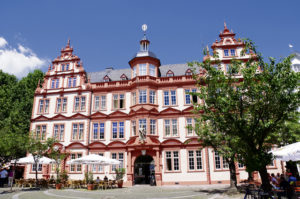Learn about history, the natural world, lots more while exploring
Most people who have spent any amount of time in the Rhein-Main region know Mainz as a famous party town — a university city known for its annual bout of carnival madness during the Fasching season.
But what many may not know is that, as the capital of Rheinland-Pfalz, Mainz is also a museum showcase. Unlike its cousin across the Rhine River, Wiesbaden (Hessen’s state capital), which has a few museum collections but looks farther east and south to Frankfurt and Darmstadt for more extensive museums, Mainzers don’t have to travel to other cities in the state to find unique accumulations of everything from great works of art to a look at the history of shipbuilding.
While Mainz’s museums may not all be located side-by-side along the river like many of those in Frankfurt on the Schaumainkai, many are within walking distance of one another in the historic city.
Mainz, like Frankfurt, suffered severely from Allied bombing during World War II. In February 1945 roughly 80 percent of the city center was blasted into oblivion — a historical fact that one can learn more about in the Landesmuseum Mainz.
Landesmuseum Mainz
Museum exhibits trace the importance of Mainz as a trade hub in the Middle Ages when traffic on the Main and Rhine rivers carried everything from wine to porcelain. Coins discovered all over the globe bearing markings from Mainz attest to the important role the town played in worldwide commerce before trading shifted farther east to Frankfurt as that city became a major market, banking and trade fair city.
Other exhibits, including stone arches from Roman times, baroque sculptures and Byzantine coins trace the city’s evolution over thousands of years.

Photo by Scirocco340/Shutterstock.com
But history is only a small part of the Mainz Landesmuseum. Artworks, art nouveau glassware and other objects on display offer opportunities to delve deeper into the world of inspiration and creativity. Discover how the United States relied heavily on Europe for luxury glass up to the 20th century before Louis C. Tiffany began inviting European artisans to America to work in his factory.
Young people will enjoy interactive computer terminals located throughout the museum that offer insights into exhibits and puzzles to solve, ranging from comparing two similar paintings for differences to assembling pieces of a well-known artwork. A special “Zeitraum” in the museum offers visitors young and old a hands-on learning opportunity.
Children are also invited to celebrate their birthdays at the museum. For information on arranging birthdays or group tours, call 06131-2857-160.
The Landesmuseum is located at Grosse Bleiche 49-51 in Mainz.
Admission is €3 for adults, €2 for students and free for children 6 and under. A family ticket costs €6.
Natural History Museum
A five-minute walk from the Landesmuseum takes one to Mainz’s Natural History Museum. The collection contained there isn’t as big as, say, the one at the Smithsonian Museum in Washington, D.C., but Mainz’s museum still offers an intriguing look at the development of animal and plant life through the course of Earth’s history. From a model of a 150-million-year-old Archaeopteryx to wild animals one might find in a German farmer’s field today, visitors will find plenty to pique their interest.
Stuffed birds in one room give visitors a better idea of the rich variety of animals that once roamed and still populate the skies in Germany. Other exhibits feature everything from ice age animals to fossilized remains.
The Natural History Museum is located at Mitternacht/Reichklarastrasse 1 in Mainz.
Admission is €1.50 for adults, 50 euro cents for children and €3 for a family ticket.
Gutenberg Museum
Interested in learning about the history of moveable type? Visit the Gutenberg Museum, located next to Mainz’s cathedral. While there, stop into the Cathedral and Diocesan Museum. Or visit the Museum of Roman Ships for a look at ancient watercraft. Another possibility is a visit to the Roman-German Central Museum, located along the river on Adenaur Ufer.
Stop by your local library for more travel information on Mainz or visit the official Mainz home page at www.mainz.de for a host of links and information about upcoming events and sights. Remember to check out each museum’s website for current hours and pricing during Covid-19.


